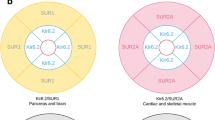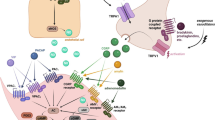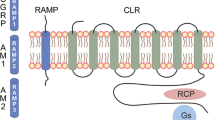Abstract
Large (big)-conductance calcium-activated potassium (BKCa) channels are expressed in migraine-related structures such as the cranial arteries, trigeminal ganglion and trigeminal spinal nucleus, and they play a substantial role in vascular tonus and neuronal excitability. Using synthetic BKCa channels openers was associated with headache as a frequent adverse effect in healthy volunteers. Additionally, BKCa channels are downstream molecules in migraine signalling pathways that are activated by several compounds known to provoke migraine, including calcitonin gene-related peptide (CGRP), pituitary adenylate cyclase-activating polypeptide (PACAP) and glyceryl trinitrate (GTN). Also, there is a high affinity and a close coupling between BKCa channels and ATP-sensitive potassium (KATP) channels, the role of which has recently been established in migraine pathophysiology. These observations raise the question as to whether direct BKCa channel activation can provoke migraine in migraine patients, and whether the BKCa channel could be a potential novel anti-migraine target. Hence, randomized and placebo-controlled clinical studies on BKCa channel openers or blockers in migraine patients are needed.




Similar content being viewed by others
References
Akerman S, Holland PR, Lasalandra MP, Goadsby PJ. Inhibition of trigeminovascular dural nociceptive afferents by Ca2+-activated K+ (MaxiK/BKCa) channel opening. Pain. 2010;151:128–36. https://doi.org/10.1016/j.pain.2010.06.028.
Al-Karagholi MA-M, Hansen JM, Severinsen J, Jansen-Olesen I, Ashina M. The KATP channel in migraine pathophysiology: a novel therapeutic target for migraine. J Headache Pain. 2017;18:90. https://doi.org/10.1186/s10194-017-0800-8.
Al-Karagholi MA-M, Hansen JM, Guo S, Olesen J, Ashina M. Opening of ATP-sensitive potassium channels causes migraine attacks: a new target for the treatment of migraine. Brain. 2019;142:2644–54. https://doi.org/10.1093/brain/awz199.
Al-Karagholi MA, Aghazadeh S, Skovgaard LT, Olesen J. Extracranial activation of ATP-sensitive potassium channels induces vasodilation without nociceptive effects. Cephalalgia. 2019;39:1–9.
Al-Karagholi MA, Sode M, Gozalov A, Ashina M. The vascular effect of glibenclamide: a systematic review. Cephalalgia Rep. 2019;2:1–13.
Al-Karagholi MA, Ghanizada H, Hansen JM, Skovgaard LT, Olesen J, Larsson HBW, et al. Levcromakalim, an adenosine triphosphate-sensitive potassium channel opener, dilates extracerebral but not cerebral arteries. Headache. 2019;59:1468–80.
Amin FM, Asghar MS, Guo S, Hougaard A, Hansen AE, Schytz HW, et al. Headache and prolonged dilatation of the middle meningeal artery by PACAP38 in healthy volunteers. Cephalalgia. 2011;32:140–9.
Asghar MS, Hansen AE, Kapijimpanga T, Van Der Geest RJ, Van Der Koning P, Larsson HBW, et al. Dilation by CGRP of middle meningeal artery and reversal by sumatriptan in normal volunteers. Neurology. 2010;75:1520–6.
Ashina M, Hansen JM, á Dunga BO, Olesen J. Human models of migraine—short-term pain for long-term gain. Nat Rev Neurol. 2017;13:713–24. https://doi.org/10.1038/nrneurol.2017.137.
Balwierczak JL, Krulan CM, Kim HS, DelGrande D, Weiss GB, Hu S. Evidence that BKCa channel activation contributes to K+ channel opener induced relaxation of the porcine coronary artery. Naunyn Schmiedebergs Arch Pharmacol. 1995;352:213–21.
Borsook D, Erpelding N, Lebel A, Linnman C, Veggeberg R, Grant PE, et al. Sex and the migraine brain. Neurobiol Dis. 2014;68:200–14. https://doi.org/10.1016/j.nbd.2014.03.008.
Chen SR, Cai YQ, Pan HL. Plasticity and emerging role of BKCa channels in nociceptive control in neuropathic pain. J Neurochem. 2009;110:352–62.
Coetzee W, Amarillo Y, Chiu J. Molecular diversity of K+ channels. Ann N Y Acad Sci. 1999;868:212–63.
Coiret G, Borowiec A. The antiestrogen tamoxifen activates BK channels and stimulates proliferation of MCF-7 breast cancer cells. Mol Pharmacol. 2007;71:843–51. https://doi.org/10.1124/mol.106.028290.the.
Contet C, Goulding SP, Kuljis DA, Barth AL. BK channels in the central nervous system. Int Rev Neurobiol. 2016;128:281–342. https://doi.org/10.1016/bs.irn.2016.04.001.
Contreras GF, Castillo K, Enrique N, Carrasquel-Ursulaez W, Castillo JP, Milesi V, et al. A BK (Slo1) channel journey from molecule to physiology. Channels. 2013;7:442–58.
Cuzick J, Forbes JF, Sestak I, Cawthorn S, Hamed H, Holli K, et al. Long-term results of tamoxifen prophylaxis for breast cancer-96-month follow-up of the randomized IBIS-I trial. J Natl Cancer Inst. 2007;99:272–82.
Dhandapani KM, Brann DW. Protective effects of estrogen and selective estrogen receptor modulators in the Brain. Biol Reprod. 2002;67:1379–85. https://doi.org/10.1095/biolreprod.102.003848.
Dick GM, Rossow CF, Smirnov S, Horowitz B, Sanders KM. Tamoxifen activates smooth muscle BK channels through the regulatory β1 subunit. J Biol Chem. 2001;276:34594–9.
Dopico AM, Bukiya AN, Jaggar JH. Calcium- and voltage-gated BK channels in vascular smooth muscle. Pflügers Arch. Eur. J. Physiol. 2018;470(9):1271–89. https://doi.org/10.1007/s00424-018-2151-y.
Edvinsson L, Gulbenkian S, Barroso CP, e Sá MC, Polak JM, Mortensen A, et al. Innervation of the human middle meningeal artery: immunohistochemistry, ultrastructure, and role of endothelium for vasomotility. Peptides. 1998;19:1213–25.
Evanson KW, Goldsmith JA, Ghosh P, Delp MD. The G protein–coupled estrogen receptor agonist, G-1, attenuates BK channel activation in cerebral arterial smooth muscle cells. Pharmacol Res Perspect. 2018;6:e00409.
Ferrari MD, Klever RR, Terwindt GM, Ayata C, van den Maagdenberg AMJM. Migraine pathophysiology: lessons from mouse models and human genetics. Lancet Neurol. 2015;14:65–80. https://doi.org/10.1016/S1474-4422(14)70220-0.
Franz M, Geppert A, Kain R, Hörl WH, Pohanka E, Mathew P, et al. Acute renal failure after ibutilide [letter]. Lancet. 1999;353:467.
Gelband CH, McCullough JR. Modulation of rabbit aortic Ca2+-activated K+ channels by pinacidil, cromakalim, and glibenclamide. Am J Physiol. 1993;264:C1119–27.
Gelband CH, Lodge NJ, Van Breemen C. A Ca2+-activated K+ channel from rabbit aorta: modulation by cromakalim. Eur J Pharmacol. 1989;167:201–10.
Ghanizada H, Al-Mahdi Al-Karagholi M, Arngrim N, Ghanizada M, Wiberg Larsson HB, et al. Effect of pituitary adenylate cyclase-activating polypeptide-27 on cerebral hemodynamics in healthy volunteers: a 3 T MRI study. Peptides. 2019;121:170134. https://doi.org/10.1016/j.peptides.2019.170134.
Ghanizada H, Al-Karagholi MA-M, Arngrim N, Olesen J, Ashina M. PACAP27 induces migraine-like attacks in migraine patients. Cephalalgia. 2020;40:57–67. https://doi.org/10.1177/0333102419864507.
Gozalov A, Jansen-Olesen I, Klaerke D, Olesen J. Role of BKCa channels in cephalic vasodilation induced by CGRP, NO and transcranial electrical stimulation in the rat. Cephalalgia. 2007;27:1120–7. https://doi.org/10.1111/j.1468-2982.2007.01409.x.
Guo S, Olesen J, Ashina M. Phosphodiesterase 3 inhibitor cilostazol induces migraine-like attacks via cyclic AMP increase. Brain. 2014;137:2951–9.
Gupta S, Villalón CM, Mehrotra S, De Vries R, Garrelds IM, Saxena PR, et al. Female sex hormones and rat dural vasodilatation to CGRP, periarterial electrical stimulation and capsaicin. Headache. 2007;47:225–35.
Haas E, Bhattacharya I, Brailoiu E, Damjanović M, Brailoiu GC, Gao X, et al. Regulatory role of G protein-coupled estrogen receptor for vascular function and obesity. Circ Res. 2009;104:288–91.
Hempelmann RG, Ziegler A, Mehdorn HM. Role of potassium channels in the relaxation induced by the nitric oxide (NO) donor DEA/NO in the isolated rat basilar artery. Neurosci Lett. 2001;313:21–4.
Hypolite JA, Lei Q, Chang S, Zderic SA, Butler S, Wein AJ, et al. Spontaneous and evoked contractions are regulated by PKC-mediated signaling in detrusor smooth muscle: involvement of BK channels. Am J Physiol Ren Physiol. 2013;304:F451–62. https://doi.org/10.1152/ajprenal.00639.2011.
Ibrahimi K, van Oosterhout WPJ, van Dorp W, Danser AHJ, Garrelds IM, Kushner SA, et al. Reduced trigeminovascular cyclicity in patients with menstrually related migraine. Neurology. 2015;84:125–31.
Jansen-Olesen I, Gulbenkian S, Engel U, e Sá CM, Edvinsson L. Peptidergic and non-peptidergic innervation and vasomotor responses of human lenticulostriate and posterior cerebral arteries. Peptides. 2004;25:2105–14.
Jensen BS. BMS-204352: a potassium channel opener developed for the treatment of stroke. CNS Drug Rev. 2002;8:353–60.
Koide M, Syed AU, Braas KM, May V, Wellman GC. Pituitary adenylate cyclase activating polypeptide (PACAP) dilates cerebellar arteries through activation of large-conductance Ca2+-activated (BK) and ATP-sensitive K+ channels. J Mol Neurosci. 2014;54:443–50.
Krishnamoorthy-Natarajan G, Koide M. BK channels in the vascular system. Int Rev Neurobiol. 2016;128:401–38. https://doi.org/10.1016/bs.irn.2016.03.017.
Kruuse C, Thomsen LL, Birk S, Olesen J. Migraine can be induced by sildenafil without changes in middle cerebral artery diameter. Brain. 2003;126:241–7.
Kyle BD, Braun AP. The regulation of BK channel activity by pre- and post-translational modifications. Front Physiol. 2014;5:1–10.
Kyle BD, Mishra RC, Braun AP. The augmentation of BK channel activity by nitric oxide signaling in rat cerebral arteries involves co-localized regulatory elements. J Cereb Blood Flow Metab. 2017;37:3759–73.
Lassen LH, Haderslev PA, Jacobsen VB, Iversen HK, Sperling B, Olesen J. CGRP may play a causative role in migraine. Cephalalgia. 2002;22:54–61.
Leo MD, Bulley S, Bannister JP, Kuruvilla KP, Narayanan D, Jaggar JH. Angiotensin II stimulates internalization and degradation of arterial myocyte plasma membrane BK channels to induce vasoconstriction. Am J Physiol Physiol. 2015;309:C392–402. https://doi.org/10.1152/ajpcell.00127.2015.
Leo MD, Zhai X, Yin W, Jaggar JH. Impaired trafficking of β1 subunits inhibits BK channels in cerebral arteries of hypertensive rats. Hypertension. 2018;72:765–75.
Leung HS, Seto SW, Kwan YW, Leung FP, Au ALS, Yung LM, et al. Endothelium-independent relaxation to raloxifene in porcine coronary artery. Eur J Pharmacol. 2007;555:178–84.
Maljevic S, Lerche H. Potassium channels: a review of broadening therapeutic possibilities for neurological diseases. J Neurol. 2013;260:2201–11.
Mistry DK, Garland CJ. Nitric oxide (NO)-induced activation of large conductance Ca2+-dependent K+ channels (BKCa) in smooth muscle cells isolated from the rat mesenteric artery. Br J Pharmacol. 1998;124:1131–40.
Morrison J, McLellan C, Minahan C. A clustered repeated-sprint running protocol for team-sport athletes performed in normobaric hypoxia. J Sport Sci Med. 2015;14:857–63.
N’Gouemo P. BKCa channel dysfunction in neurological diseases. Front Physiol. 2014;5:1–6.
Nardi A, Olesen S. BK channel modulators: a comprehensive overview. Cuur Med Chem. 2008;15:1126–46.
Olesen J, Gustavsson A, Svensson M, Wittchen HU, Jönsson B. The economic cost of brain disorders in Europe. Eur J Neurol. 2012;19:155–62.
Park SY. Cilostazol suppresses superoxide production and expression of adhesion molecules in human endothelial cells via mediation of cAMP-dependent protein kinase-mediated Maxi-K channel activation. J Pharmacol Exp Ther. 2006;317:1238–45. https://doi.org/10.1124/jpet.105.098509.
Persiani S, D’Amato M, Makovec F, Arshad SH, Holgate ST, Rovati LC. Pharmacokinetics of andolast after administration of single escalating doses by inhalation in mild asthmatic patients. Biopharm Drug Dispos. 2001;22:73–81.
Poulsen AN, Wulf H, Hay-Schmidt A, Jansen-Olesen I, Olesen J, Klaerke DA. Differential expression of BK channel isoforms and β-subunits in rat neuro-vascular tissues. Biochim Biophys Acta. 2009;1788:380–9. https://doi.org/10.1016/j.bbamem.2008.10.001.
Ray CJ, Marshall JM. The cellular mechanisms by which adenosine evokes release of nitric oxide from rat aortic endothelium. J Physiol. 2006;570:85–96.
Schubert R, Nelson MT. Protein kinases : tuners of the BKCa channel in smooth muscle. Trends Pharmacol Sci. 2001;22:505–12.
Schytz HW, Birk S, Wienecke T, Kruuse C, Olesen J, Ashina M. PACAP38 induces migraine-like attacks in patients with migraine without aura. Brain. 2009;132:16–25.
Smitherman TA, Kolivas ED. Resolution of menstrually related migraine following aggressive treatment for breast cancer. Headache. 2010;50:485–8.
Storer RJ, Akerman S, Goadsby PJ. Calcitonin gene-related peptide (CGRP) modulates nociceptive trigeminovascular transmission in the cat. Br J Pharmacol. 2004;142:1171–81.
Storer RJ, Immke DC, Yin R, Goadsby PJ. Large conductance calcium-activated potassium channels (BKCa) modulate trigeminovascular nociceptive transmission. Cephalalgia. 2009;29:1242–58.
Syed AU, Koide M, Braas KM, May V, Wellman GC. Pituitary adenylate cyclase-activating polypeptide (PACAP) potently dilates middle meningeal arteries: implications for migraine. J Mol Neurosci. 2012;48:574–83.
Thomsen LL, Kruuse C, Iversen HK, Olesen J. A nitric oxide donor (nitroglycerin) triggers genuine migraine attacks. Eur J Neurol. 1994;1:73–80.
van Oosterhout WPJ, Schoonman GG, van Zwet EW, Dekkers OM, Terwindt GM, VanDen Maassen Brink A, et al. Female sex hormones in men with migraine. Neurology. 2018;91:e374–81. https://doi.org/10.1212/WNL.0000000000005855.
Vaudry D, Falluel-morel A, Bourgault S, Basille M, Burel D, Wurtz O, et al. Pituitary adenylate cyclase-activating polypeptide and its receptors: 20 years after the discovery. Pept Res. 2009;61:283–357. https://doi.org/10.1124/pr.109.001370.283.
Vetvik KG, MacGregor EA. Sex differences in the epidemiology, clinical features, and pathophysiology of migraine. Lancet Neurol. 2017;16:76–87.
Wallis RM. The pharmacology of sildenafil, a novel and selective inhibitor of phosphodiesterase (PDE) type 5. Nihon Yakurigaku Zasshi. 1999;114(Suppl):22P–6P.
Wienecke T, Olesen J, Ashina M. Prostaglandin I2 (epoprostenol) triggers migraine-like attacks in migraineurs. Cephalalgia. 2010;30:179–90.
Wu SN, Liu SI, Huang MH. Cilostazol, an inhibitor of type 3 phosphodiesterase, stimulates large-conductance, calcium-activated potassium channels in pituitary GH3 cells and pheochromocytoma PC12 cells. Endocrinology. 2004;145:1175–84.
Wulf-Johansson H, Amrutkar DV, Hay-Schmidt A, Poulsen AN, Klaerke DA, Olesen J, et al. Localization of large conductance calcium-activated potassium channels and their effect on calcitonin gene-related peptide release in the rat trigemino–neuronal pathway. Neuroscience. 2010;167:1091–102. https://doi.org/10.1016/j.neuroscience.2010.02.063.
Ye QL, Zhai ZM. Toremifene and tamoxifen have similar efficacy in the treatment of patients with breast cancer: a meta-analysis of randomized trials. Mol Biol Rep. 2014;41:751–6.
Yu X, Ma H, Barman SA, Liu AT, Sellers M, Stallone JN, et al. Activation of G protein-coupled estrogen receptor induces endothelium-independent relaxation of coronary artery smooth muscle. AJP Endocrinol Metab. 2011;301:E882–8. https://doi.org/10.1152/ajpendo.00037.2011.
Yu X, Li F, Klussmann E, Stallone JN, Han G. G protein-coupled estrogen receptor 1 mediates relaxation of coronary arteries via cAMP/PKA-dependent activation of MLCP. Am J Physiol Metab. 2014;307:E398–407. https://doi.org/10.1152/ajpendo.00534.2013.
Zagami AS, Edvinsson L, Goadsby PJ. Pituitary adenylate cyclase activating polypeptide and migraine. Ann Clin Transl Neurol. 2014;1:1036–40.
Zhang XF, Gopalakrishnan M, Shieh CC. Modulation of action potential firing by iberiotoxin and NS1619 in rat dorsal root ganglion neurons. Neuroscience. 2003;122:1003–11.
Zhang D, Krishna R, Wang L, Zeng J, Mitroka J, Dai R, et al. Metabolism, pharmacokinetics, and protein covalent binding of radiolabeled MaxiPost (BMS-204352) in humans. Drug Metab Dispos. 2005;33:83–93.
Zhang H, Xie M, Schools GP, Feustel PF, Wang W, Lei T, et al. Tamoxifen mediated estrogen receptor activation protects against early impairment of hippocampal neuron excitability in an oxygen/glucose deprivation brain slice ischemia model. Brain Res. 2009;1247:196–211. https://doi.org/10.1016/j.brainres.2008.10.015.
Zhu S, Han G, White RE. PGE2 action in human coronary artery smooth muscle: role of potassium channels and signaling cross-talk. J Vasc Res. 2002;39:477–88.
Zunt JR, Kassebaum NJ, Blake N, Glennie L, Wright C, Nichols E, et al. Global, regional, and national burden of neurological disorders, 1990–2016: a systematic analysis for the Global Burden of Disease Study 2016. Lancet Neurol. 2019;17:1061–82.
Author information
Authors and Affiliations
Corresponding author
Ethics declarations
Funding
No sources of funding were used to assist with the preparation of this review.
Conflict of interest
Messoud Ashina (MA) reports personal fees from Allergan, Amgen, Alder, Eli Lilly, Novartis and Teva. MA has no ownership interest and does not own stocks of any pharmaceutical company. MA serves as associated editor of Cephalalgia and co-editor of the Journal of Headache and Pain. MA is the President of the International Headache Society and General Secretary of the European Headache Federation. Mohammad Al-Mahdi Al-Karagholi (MMK) has acted as an invited speaker for Novartis and received travel grant from ElectroCore. Christian Gram and Cherie Amalie Waldorff Nielsen declare no conflict of interest.
Rights and permissions
About this article
Cite this article
Al-Karagholi, M.AM., Gram, C., Nielsen, C.A.W. et al. Targeting BKCa Channels in Migraine: Rationale and Perspectives. CNS Drugs 34, 325–335 (2020). https://doi.org/10.1007/s40263-020-00706-8
Published:
Issue Date:
DOI: https://doi.org/10.1007/s40263-020-00706-8




